 |
surfresearch.com.au
witzig : maui 1967, 1968 |
John Witzig : The Australians in Hawaii - Part 2 Maui, 1968.
Witzig, John: The Australians in Hawaii, Part 2 - Maui.
Surf International Vol. 1. No. 5 May 1968 pages 20 to 29.
| home | catalogue | history | references | appendix |
 |
surfresearch.com.au
witzig : maui 1967, 1968 |
For Maui is
indeed a paradise.
And yet in
the same breath one must deny the fact.
The
luxuriant vegetation that should cover the small island
simply doesn't.
It is the
difference between reality and fantasy.
In some ways
it satisfies all the demands that one educated to the idea
of an island paradise might demand.
In other
ways this lovely little island is barren and indeed
unlovely.
Where it is
great, Maui is superb.
It is an
island of contrasts.
The long
extinct crater of Haleakala is cold and grey and brown and
so vast and empty.
And Hana.
Or more
particularly the road to Hana that is everything anyone has
ever said about paradise.
Deep and
green and great.
Lahaina : an
early whaling town that is losing its atmosphere as it loses
innocence.
And Honolua,
the surfers' dream.
The right
that is like a combination of Rincon and National Park.
The rocks
that are like the worst of both.
We went to
Maui in December.
We sat and
waited for the Bay.
Honolua.
The cliffs
around are steep and barren.
The hills
that become mountains just sit in the clouds.
And at the
eye of this fantastic bay is the jungle.
With guavas
and pawpaws and passion fruit and mangoes and breadfruit and
the Real Islands.
Coconuts and
confusion.
Midget said
of Honolua, "It's like National ought to be".
McTavish:
"It's Buddy Boy's Bay."
God knows,
it's a beautiful wave.
And Buddy
Boy does know it well.
At the back
of his pin tail.
The pin tail
shaped by the doyen of big wave shapers, Dick Brewer.
Eberly (sic)
uses a Brewer at Wiamea.
Cabell at
Makaha.
Buddy Boy
uses one at Honolua.
And on a big
day breaks it into two pieces.
Along with
Nat and Ted Spencer and Reno Abellira and someone else.
Dick Brewer
lives half of the time in his camper which is on the back of
his truck.
And half of
that ...
Page 21
Photographs:
Unknown
(Buddy Boy), Honolua Bay.
Honolua
Bay #1.
Nat
samples the guavas.
| Page
22 Reno Abellira brings his new
board back to shore.
On this day of big Honolua Bay surf, three boards were broken in half. The Pioneer Inn- the place to
stay in Lahaina.
|
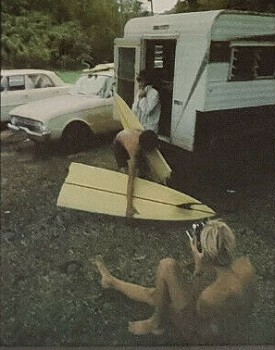 |
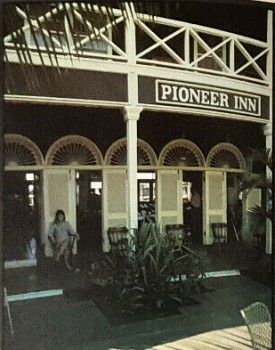 |
For if the island of Maui had nothing else for the surfer, then the Bay would be enough.
Maui isn't
a very big island.
When it is
onshore on one side of the island, then it is offshore on
the other and you drive there.
There is surf near Lahaina and near Hana, which is at the
other end and on the other side of the island.
And there is
surf on much of the coast in between.
And if there
is no surf then you can drive up to the crater at Haleakala.
Up ten
thousand feet, the cold is a shock after the 80 degrees at
sea level (and this is winter).
From the top
at Haleakala you can see Mona Koa which is on the island of
Hawaii.
It is
covered with snow.
There are
no trees in the crater.
The clouds
slip into the giant bowl through the breaks in the lip.
You could
walk through the barrenness for days.
It is
unreal, especially for a tropical island.
It is so
silent that the only thing you can hear is the buzzing in
your ears.
After a
couple of hours this disappears too.
You drive
down again to the sea.
The road is
about as wide as a big footpath.
There is an
optimistic white line down the centre.
Half way
down this remarkable mountain there is a grove of Australian
eucalypts.
They only
heighten the unreality.
And half way
down there is a town too, where we stopped to buy petrol and
a six pack of Primo, the Hawaiian beer.
Nat referred
to the old fellow who filled our car as china-you know,
plate: mate- he was Korean or Japanese or something and we
don't think he really appreciated the humour.
Lahaina is
where the missionaries settled.
Apparently
before they came, it was a pretty wild town.
I don't know
where they went to, but it's not exactly a quiet town now.
There is
plenty going on in quiet rooms.
The Pioneer
Inn is where you stay in Lahaina.
A tent on
the outskirts of town is where we stayed.
Partly
because it was cheap and more particularly because it was
empty.
We used to
eat at the Pioneer which must be the only place in the
United ...
| Page
23
|
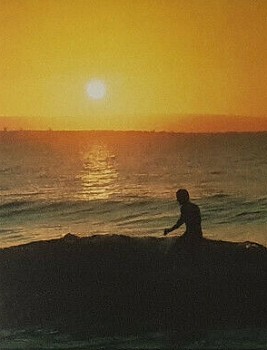 Russell Hughes on at late afternoon wave at Honolua Bay. |
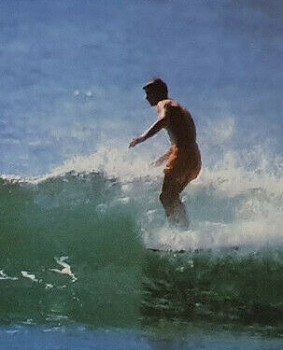 Ted Spencer at Sandbox. This is a small right a couple of miles along coast from Lahaina. |
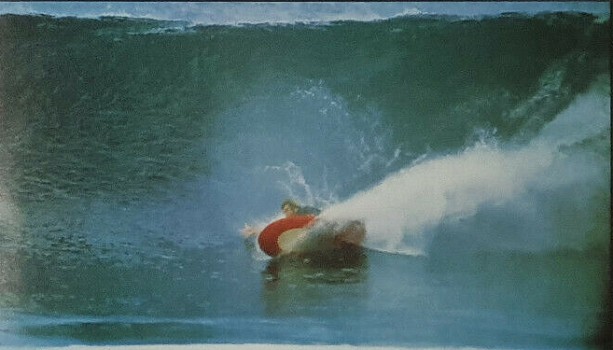 The fantastic surfing of George
Greenough.
His fin is virtually clear of the Honolua wave as he pushes his board into a savage bank turn on the rail.. |
Page 25
Photographs: (1) Haleakala.
(2)Pioneer
Inn #2.
... States
where a steak costs $2.50.
You cook it
yourself which is better anyway.
The Pioneer
Inn is loaded with atmosphere which is good or bad depending
on which way you look at it.
There is a
little harbour in front of the Pioneer.
In it is an
old whaler, the Carthaginian.
Just to the
right is a small break.
At times it
is very good.
But nearly
everything in Maui is very good.
And probably
Christmas Day would have been if we had been a little
prepared.
It started
with Greenough finding the bottle.
Oddly enough
it wished us a happy Christmas and reasonably it told us a
life history.
It had been
launched by a small child in the apartment across from our
flat.
She or he
had indulged in the fantasy of childhood- the message in the
bottle.
This was
one of the better things that happened at Christmas.
Admittedly,
on the previous evening our Californian friend Steve had
come around with our only present.
A French
pastry.
It was
devoured with Christmas spirit which was the only gift that
we had to return.
Christmas
dinner was a bummer.
I think we
had intended to go to the Pioneer Inn.
But it
wasn't open.
The last
supermarket in the town was.
Christmas
dinner was V8 juice and salted peanuts.
It wasn't
exactly overpowered by Chrissy joy and salutations.
And the sign
on the church near Lahaina reads "Christ-coming soon".
When?
But the
next day and the next are Honolua and everything is
forgiven.
Honolua just
after dawn.
Honolua in
the heat of midday.
Honolua with
the last light of a sinking sun.
And Honolua
with a good swell.
God's answer
to prayers that hadn't been mouthed.
And one day,
when the swell had just snuck around the corner of Molokai,
it was nearly ours alone.
Maui used
to be empty of surfers and tourists.
It's not any
more.
There are
big hotels at Kanapali.
And a cruise
ship that comes in every few weeks or so.
And sweet
little Maui takes their money and laughs and cries.
Maui, like
everywhere else, is selling out.
But she is
going very dear.
There were
only the rich ...
| Page 26 |
|
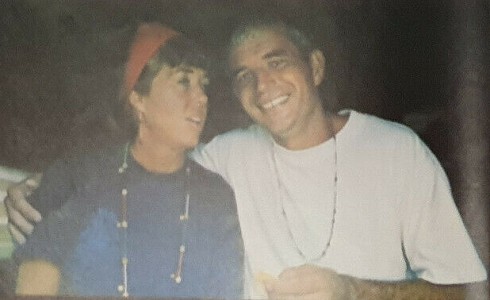 Residents of Maui, top shaper Dick Brewer and his wife Betty . |
| Page 27 |
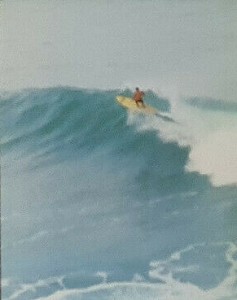 Nat in an amazing manoeuvre at
Honolua Bay.
|
 The old whaler, the Carthaginian,
leaving Lahaina Harbour. |
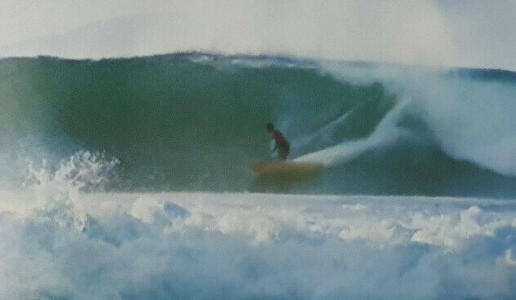 Nat on a large Honolua wave.
The (...) afternoon light catches the white water. |
Page 29
Photograph: Honolua Bay #4 (black and white).
... and the
surfers.
And for the
surfers the Dolphin which is the only place in the islands
where you can get decent food. Yoghurt and fruit and soup. .
The Dolphin.
Duke's
place.
Where you
used to pay just what you felt it was worth, or else what
you could.
And like
everywhere else this is changed.
ust not
enough people paid and now there are prices.
So
beautiful Maui changes before your eyes: the ironic isle.
The paradise
that really isn't.
But when you
fly out over the maze of cane fields, you remember the
coconuts that you split open
to drink the
milk.
You remember
the rain forest and the other fruit.
You remember
the waves, and perhaps most of all you remember the
macadamia-nut ice cream.
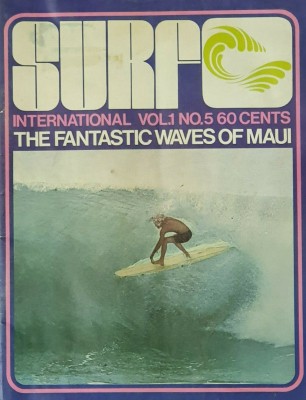 |
Surf International Vol. 1. No. 5 May 1968. Cover: Buddy Boy, Honolua Bay. |
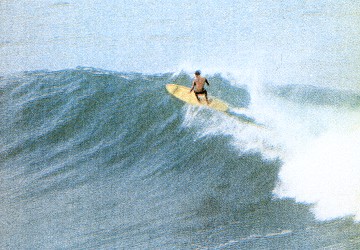 Page
27: Nat Young, Honolua Bay.
detail |

| home | catalogue | history | references | appendix |